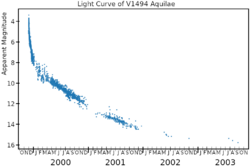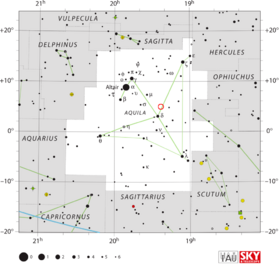Astronomy:V1494 Aquilae
| Observation data Equinox J2000.0]] (ICRS) | |
|---|---|
| Constellation | Aquila |
| Right ascension | 19h 23m 05.30s[1] |
| Declination | 04° 57′ 19.1″[1] |
| Apparent magnitude (V) | 3.9 Max. 17.1 Min.[2][3] |
| Characteristics | |
| Variable type | Classical Nova[3], eclipsing binary[4] |
| Astrometry | |
| Parallax (π) | 0.5615 ± 0.1281[5] mas |
| Distance | 1,239+422 −127[3] pc |
| Absolute magnitude (MV) | −8.2 Max. 4.8 Min.[2][3] |
| Orbit[6] | |
| Period (P) | 0.1346 days |
| Semi-major axis (a) | 1.17 - 1.24 R☉ |
| Inclination (i) | 78.5[7]° |
| Details | |
| white dwarf | |
| Mass | 0.92 - 1.13[6] M☉ |
| Luminosity | 750 - 3,000[7] L☉ |
| Temperature | >100,000 (2000)[8] K |
| donor | |
| Mass | 0.28[6] M☉ |
| Temperature | 3,000[7] K |
| Other designations | |
| Database references | |
| SIMBAD | data |

V1494 Aquilae or Nova Aquilae 1999 b was a nova which occurred during 1999 in the constellation Aquila and reached a brightness of magnitude 3.9 on 2 December 1999.[2] making it easily visible to the naked eye.[9] The nova was discovered with 14×100 binoculars by Alfredo Pereira of Cabo da Roca, Portugal at 18:50 UT on 1 December 1999, when it had a visual magnitude of 6.0.[10]
V1494 Aquilae is classified as a fast nova, meaning it faded from peak brightness by more than 3 magnitudes in less than 100 days.[11] During its decline, V1494 Aql produced unusual variations in its x-ray radiation, including a bright burst lasting several minutes. During 2000, the x-ray spectrum developed from a hard (high energy) emission-line spectrum to a spectrum typical of a super soft X-ray source. The x-ray intensity varied with a period of about 40 minutes, probably due to pulsations induced in the white dwarf by its re-kindled hydrogen fusion.[8]
All novae are binary systems with two stars orbiting so close to each other that one star, the "donor" star transfers matter to the other star which is a white dwarf. In the case of V1494 the white dwarf has a mass of 1.20M☉, and it is accreting mass from the donor star at a rate of 2.1 × 10−10 M☉ yr−1.[12] The stars' orbital period is 3.23 hours,[11] and the system is an eclipsing binary with two brightness minima each orbit, one 0.5 and one 0.1 magnitudes deep.[2][4] This apparently is a measurement of two stars of approximately equal brightness, the nova and a companion 1.4″ to the south east. Measuring only the brightness of the nova, the eclipses are about two magnitudes deep.[13] The white dwarf is probably an oxygen-neon-magnesium type.[6]
Unlike some novae, the material ejected from V1494 Aquilae has not formed a visible nebula around the star.[14] However, a shell approximately 6.5″ across has been detected spectroscopically in H-alpha emission.[13]
The distance to V1494 Aquilae has been estimated by different methods. Early estimates were based on assumptions about the luminosity of the nova and gave distances around 1.2 kpc.[7] Later models assumed distances of up to 2.2 kpc.[6] Comparison of the measured shell size with the observed expansion velocity give a distance of 1.2±0.2 kpc.[13] Gaia DR2 published a parallax of 0.8394±0.1415 mas, corresponding to a distance of 1,239+422
−127 kpc.[3] Gaia EDR3 published a parallax of 0.5615±0.1281 mas, corresponding to a distance around 1,800 kpc.[5]
References
- ↑ 1.0 1.1 "V1494 Aql". SIMBAD. Centre de données astronomiques de Strasbourg. http://simbad.u-strasbg.fr/simbad/sim-basic?Ident=V1494+Aql.
- ↑ 2.0 2.1 2.2 2.3 Barsukova, E.A.; Goranskii, V.P. (March 2003). "The Orbital Period of Nova Aquilae 1999 No. 2 (V1494 Aql)". Astronomy Letters 29 (3): 195–198. doi:10.1134/1.1558159. Bibcode: 2003AstL...29..195B.
- ↑ 3.0 3.1 3.2 3.3 3.4 Schaefer, Bradley E. (2018). "The distances to Novae as seen by Gaia". Monthly Notices of the Royal Astronomical Society 481 (3): 3033–3051. doi:10.1093/mnras/sty2388. Bibcode: 2018MNRAS.481.3033S.
- ↑ 4.0 4.1 Kato, Taichi; Ishioka, Ryoko; Uemura, Makoto; Starkey, Donn R.; Krajci, Tom (March 2004). "V1494 Aql: Eclipsing Fast Nova with an Unusual Orbital Light Curve". Publications of the Astronomical Society of Japan 56: S125–S131. doi:10.1093/pasj/56.sp1.S125. Bibcode: 2004PASJ...56S.125K.
- ↑ 5.0 5.1 Brown, A. G. A. (2021). "Gaia Early Data Release 3: Summary of the contents and survey properties". Astronomy & Astrophysics 649: A1. doi:10.1051/0004-6361/202039657. Bibcode: 2021A&A...649A...1G. Gaia EDR3 record for this source at VizieR.
- ↑ 6.0 6.1 6.2 6.3 6.4 Hachisu, Izumi; Kato, Mariko (2010). "A Prediction Formula of Supersoft X-Ray Phase of Classical Novae". The Astrophysical Journal 709 (2): 680–714. doi:10.1088/0004-637X/709/2/680. Bibcode: 2010ApJ...709..680H.
- ↑ 7.0 7.1 7.2 7.3 Hachisu, Izumi; Kato, Mariko; Kato, Taichi (2004). "Detection of Two-armed Spiral Shocks on the Accretion Disk of the Eclipsing Fast Nova V1494 Aquilae". The Astrophysical Journal 606 (2): L139–L142. doi:10.1086/421295. Bibcode: 2004ApJ...606L.139H.
- ↑ 8.0 8.1 Drake, Jeremy J.; Wagner, R. Mark; Starrfield, Sumner; Butt, Yousaf; Krautter, Joachim; Bond, H. E.; Della Valle, M.; Gehrz, R. D. et al. (2003). "The Extraordinary X‐ray Light Curve of the Classical Nova V1494 Aquilae (1999 No. 2) in Outburst: The Discovery of Pulsations and a "Burst"". The Astrophysical Journal 584 (1): 448–452. doi:10.1086/345534. Bibcode: 2003ApJ...584..448D.
- ↑ Nemiroff, R.; Bonnell, J., eds (15 December 1999). "A Nova in Aquila". Astronomy Picture of the Day. NASA. https://apod.nasa.gov/apod/ap991215.html.
- ↑ Dicicco, D.; Vitorino, C.; Green, D.W.E. (December 1999). "Nova Aquilae 1999 No. 2". IAU Circular 7323: 1. Bibcode: 1999IAUC.7323....1D.
- ↑ 11.0 11.1 Ritter, H.; Kolb, U. (June 2003). "Catalogue of cataclysmic binaries, low-mass X-ray binaries and related objects (Seventh edition)". Astronomy & Astrophysics 404: 301–303. doi:10.1051/0004-6361:20030330. Bibcode: 2003A&A...404..301R.
- ↑ Shara, Michael M.; Prialnik, Dina; Hillman, Yael; Kovetz, Attay (June 2018). "The Masses and Accretion Rates of White Dwarfs in Classical and Recurrent Novae". The Astrophysical Journal 860 (2): 110. doi:10.3847/1538-4357/aabfbd. Bibcode: 2018ApJ...860..110S.
- ↑ 13.0 13.1 13.2 Barsukova, E. A.; Valeev, A. F.; Goranskij, V. P.; Zharova, A. V. (October 2013). "Spectroscopic detection of resolved ejecta of nova V1494 Aql". The Astronomer's Telegram 5454 (5454): 1. Bibcode: 2013ATel.5454....1B.
- ↑ Sahman, D.I.; Dhillon, V.S.; Knigge, C.; Marsh, T.R. (August 2015). "Searching for nova shells around cataclysmic variables". Monthly Notices of the Royal Astronomical Society 451 (3): 2863–2876. doi:10.1093/mnras/stv1150. Bibcode: 2015MNRAS.451.2863S.
External links
- www.tsm.toyama.toyama.jp
- Simbad
- Image V1494 Aquilae
- V1494 Aql International Variable Star Index
- V1494 Aql AAVSO comparison chart
Coordinates: ![]() 19h 23m 05.38s, +04° 57′ 20.1″
19h 23m 05.38s, +04° 57′ 20.1″
 |


